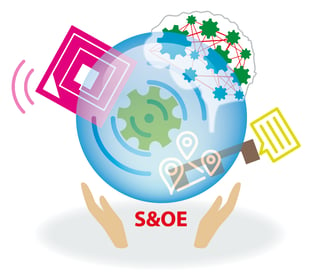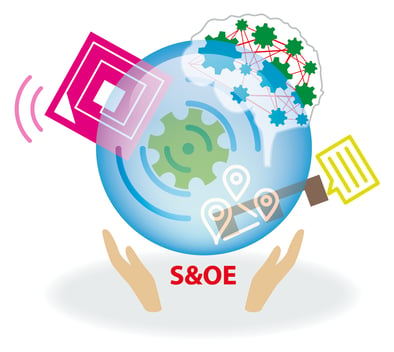How S&OE Will Impact the Manufacturing Industry
Jesse Kelber - September 03, 2019

 Today we’re dusting off our supply chain crystal ball and are going to give you a glimpse of what inventory management may very well look like ten years from now given the advancements made in just the last five years or so. Logistics 4.0 is combining with Industry 4.0 to lead to massive disruptions in how the manufacturing value chain is run. IoT sensors, RFID tags, and AI are allowing for more automation, and advanced analytics are giving planners unparalleled transparency into the supply chain. This combination is potent in its ability to allow for more accurate forecasting and planning adjustments down to the day or even hour. In the future, these practices will eventually reach even wider adoption, becoming ubiquitous across sectors and allowing inventory management to ditch the pen and spreadsheet once and for all.
Today we’re dusting off our supply chain crystal ball and are going to give you a glimpse of what inventory management may very well look like ten years from now given the advancements made in just the last five years or so. Logistics 4.0 is combining with Industry 4.0 to lead to massive disruptions in how the manufacturing value chain is run. IoT sensors, RFID tags, and AI are allowing for more automation, and advanced analytics are giving planners unparalleled transparency into the supply chain. This combination is potent in its ability to allow for more accurate forecasting and planning adjustments down to the day or even hour. In the future, these practices will eventually reach even wider adoption, becoming ubiquitous across sectors and allowing inventory management to ditch the pen and spreadsheet once and for all.
These emerging technologies are having a huge impact on the manufacturing sector, with recent years seeing radical change up and down the supply chain. Everything from Industry 4.0 technologies like IoT sensors, RFID tags, and smart pallets to software innovations like AI and machine learning are making their presence felt. One of the more interesting methodologies to emerge from this mixing of new tech with old-line techniques is what Garner recently termed “Sales and Operation Execution,” or S&OE. This set of methods, techniques, and tactics are to daily and weekly planning what S&OP is to monthly and quarterly planning. In this way, planners can create an environment where pivots and adjustments to shipments are possible in a matter of hours where once they took days at a minimum. By relying on real-time data and visibility into the end-to-end supply chain, S&OE enables the quick pivots and shuffling of inventory necessary to meet immediate demand fluctuations and other near-term situations.
Hypothetical Scenarios From the Not-Too-Distant Future
Our crystal ball is set to the year 2030, far enough out for the emerging technologies of today to be well-established and have a good track record of success. The scenarios we’re going to look at are hypothetical in their use of this technology, but they’re very real in the sense of being based on situations any logistics planner has dealt with on a daily or weekly basis.
Smart pallets alert you to an impending storm
You have a shipment of raw materials on its way from Southeast Asia—a shipment you’re depending on to fulfill a big order for your best customer—and the smart pallets your items are on have just alerted you to a storm. By measuring atmospheric conditions in their immediate proximity, they sensed the dramatic shift in pressure that precedes such a storm even before the weather services put the word out. As part of your S&OE workflow, this alert means you’re able to shift resources from another production facility to the one responsible for this large order, leading to the order being completed on time with minimal impact on your other facilities or orders and meaning your S&OP planners never even have to know anything went sideways.
A last-minute order has come in that will wipe out inventory at warehouse 1
And you have a standing order coming up that was relying on that inventory. Advanced analytics that run on all incoming orders before sending the production order to the floor alert you to this situation. This allows you to check on inventory at other facilities, adjust shipments, and re-allocate the resources necessary to fulfill both the last-minute order AND the outstanding one from available stock on hand. And that means you avert the potential disaster of late deliveries that were a virtual certainty in the pre-S&OE era of logistics planning. The day is saved, and your customer goes home happy to be doing business with you.
Factory 2 just sent out a notice of upcoming machine downtime
IoT sensors on your production line monitor the ongoing health status of your equipment, and factory 2 just sent out an alert that a main piece of machinery is going to need some maintenance in the very near future. That means you’ve got less than a day to shuffle production from there to other factories, delay orders, and redirect incoming raw materials orders. But since you were alerted ahead of time, what you aren’t dealing with is unexpected disruptions and you’re able to use the technologies you put in place to accomplish all of that logistics shuffling before lunch. Now your production run can proceed apace, your customers will receive their orders right on time, and you can move on to planning their next order since they’re so excited to continue working with such a fantastically well-organized company.
A major storm just tore up a stretch of road between you and one of your major customers
All of your shipments go out with satellite-enabled RFID tags in place, and your shipping fleet consists of semi-autonomous trucks with IoT enabled tracking and GPS systems. So you’re able to send new routing information directly to each truck depending on its final destination and have the trucks themselves send alerts to your customers letting them know of the potential delay in receiving their goods. But since all of this happened in a matter of minutes, everything arrives right on time despite the relatively major disruption to trucking that such a storm causes. This is the power of S&OE workflows that are based on real-time data and instantaneous alert capabilities.
Reporting came back on last weeks production numbers, and they show an anomaly
With IoT sensors reporting and analytics running on all production lines leading to complete transparency into the end-to-end production process, it’s a simple matter of searching the data to locate the root cause. And with your digital twin in place, you can run forecast models to be sure the solution that is put in place will indeed work into the foreseeable future.
This was a fun exercise in forecasting of a different sort. Technology changes fast, and in order to keep up the manufacturing world will have to learn how to adopt these emerging technologies wherever possible. As you saw through these theoretical examples, some of the existing tech that you may already rely on will mature and find its place in everyday inventory planning. From there, integration with other technologies will mean revolutionary levels of transparency and data availability for AI and machine learning to dive into. And once that happens, only time will tell what direction manufacturing and logistics will go.
LATEST POSTS
- Understand Why Production Planning Needs Specialized Solutions
- Understand Circular Economy in The Manufacturing Industry
- How Can Industry 4.0 IT Integration Be Achieved Smoothly?
- The Significance of Order Sequencing in Discrete Manufacturing
- How to improve your Supply Chain Management: The Power of Control Towers



